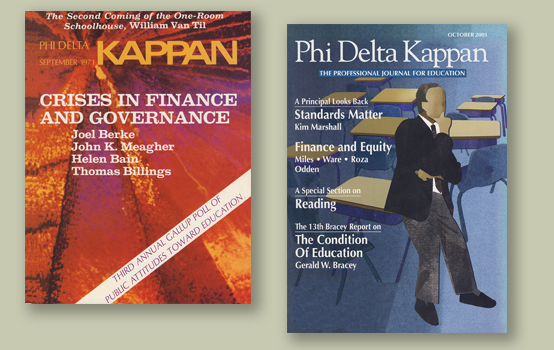As governments, voters, and courts have made decisions about how to fund schools, Kappan authors have weighed in with their own ideas.
Questions about how best to fund public schools have concerned Kappan authors for decades. After all, funding affects how well schools can achieve their missions, and insofar as the schools’ mission is to educate everyone, educators have had to consider how to ensure that everyone receives an appropriate education. But what that looks like has varied, depending on the time and place.
In February 1948, Earle Liggitt (“Financing our public schools”) asserted that:
it is a general principle of our democracy that every child be provided the opportunity to obtain a public school education. However, the scope, the character, and the financing of the public school offerings and programs are left primarily to the individual states and to the local communities. (p. 271)
And, indeed, different states have made different decisions about how to acquire and distribute funds for their schools. However, as early as April 1939, Alfred Dexter Simpson (“Trends in American School Finance”) speculated that a desire for equity would eventually lead to greater federal aid to schools. However, for the most part, school funding has remained a state and local concern.
States, taxes, and school funding
In November 1969, as part of a special issue on school finance, Arthur Wise (“The constitutional challenge to inequities in school finance”) pointed out the inherent unfairness in states’ approaches to school funding. Because most states relied on local property taxes to fund schools, districts with higher property values also received more school funding, even when poor districts taxed themselves at a higher rate. Might such funding disparities amount to a violation of the Equal Protection Clause?
The concept of equal protection requires the uniform treatment of persons standing in the same relation to the governmental action in question. It does not require that persons different in fact be treated in law as though they were the same. It does require that those who are similar be similarly treated.
While the method for allocating educational funds must be changed, there must be a rational basis for allocating these funds. What is clear is that the amount of money spent on a child should not depend upon his parents’ economic circumstances or his location within the state. (p. 147)
Wise proposed that, instead of funding schools according to their local tax base, states should allocate each school a roughly equal amount per pupil, with some additional support made available to schools with higher levels of poverty or low academic achievement.
In that same issue, August Steinhilber (“The judicial assault on state school aids laws: Problems and prognosis”) looked beyond the Equal Protection Clause when seeking potential arguments against unfair finance structures:
A better chance for success would exist if the grounds for relief were broadened to include more than the “equal protection” argument. That argument applies to state assumed functions: If a state undertakes a function, it must treat all under similar circumstances alike. Perhaps the argument could be strengthened by including the “Due Process” clause of the Fourteenth Amendment, which forbids states from depriving persons of life, liberty, or property without due process of law. In the evolution of our nation and the development of personal needs, the right to an adequate education may have become a personal freedom (p. 152)
In September 1971, Joel Berke (“The current crisis in school finance: Inadequacy and inequity”) argued against the use of property taxes for school funding, but he avoided the constitutional argument and focused instead on the inherent unfairness of this method of funding schools. Not only did the property tax make it easier for wealthy communities to raise significant sums, over and above what poor districts could raise, but the districts raising the lowest sums had the greatest need:
The arbitrariness of the local property tax would be a serious enough indictment in itself. Exacerbating its defects, however, is a distribution of taxable wealth that is unrelated and often inversely related to the need for educational services. Thus communities with higher proportions of children from minority groups or impoverished homes — pupils requiring high-cost education programs to achieve at average grade levels — tend to be the poorer districts with less ability to provide high-quality education. If, as I believe, one of the major purposes of education in America is to serve as a vehicle for social mobility — to provide an opportunity for individuals to compensate for educational disadvantages associated with family background — then educational services should be distributed in inverse proportion to family wealth and social advantagement. Yet the reliance upon the local property tax for the bulk of educational revenues as it is presently administered virtually assures that the rich will get richer in terms of the educational benefits they receive. (p. 4)
Although public opinion did seem to be shifting toward reduced reliance on property taxes, according to a September 1974 article by Donna Shalala and Mary Frase Williams (“State tax politics, the voters, and school finance reform”), voters still failed to pass state constitutional amendments that would make this shift a reality. Shalala and Williams speculated that it was not the move away from property taxes that voters objected to, but other aspects of the amendments, such as new taxes and the potential loss of local control of schools.
Through the courts
By the 1970s, the courts were taking on cases related to school finance. In October 1972, LeBaron Preston (“The Supreme Court and school finance: Some possibilities”) considered the potential of such cases to transform education:
The school finance cases offer a bright hope for the future of public education. Indeed, their impact may go beyond education, for if revenue available for schools becomes independent of the assessable tax base of school districts, the desire to exclude low income residents and to attract industry should diminish; and it may become easier to change the shape of local school districts for integration and other purposes. (p. 123)
Two cases that received significant attention in Kappan in the 1970s were Serrano v. Priest in California and San Antonio Independent School District v. Rodriguez, originating in Texas and going all the way to the U.S. Supreme Court. John Pincus (“The Serrano case: Policy for education or for public finance?”) delved into the significance of the two cases in the November 1977 Kappan. Although, in 1973, the U.S. Supreme Court had ruled in Rodriguez that the Texas funding system was not in violation of the Equal Protection Clause, the California Supreme Court affirmed in Serrano a prior ruling that its state’s funding system “was unconstitutional on equal protection grounds in part because of invidious discrimination against the poor child, the quality of whose education, like that of the rich, was a function of the wealth of his parents and neighbors” (p. 174).
The Rodriguez case received further attention in the March 1983 issue, which featured articles reflecting on the ruling. In his interview titled “A decade after Rodriguez,” John Coons observed that, in its ruling on the case:
the Court denied the society a unique opportunity to open up a decadent and discriminatory system to public dialog and the political process. I still believe that, if a way could be found to unlock that process, the ensuing debate could reform and revitalize education. (p. 480)
According to David Long (“Rodriguez: The state courts respond”), that debate was occurring on the state level, where some courts were striking down funding systems that discriminated against children in poor school districts and others upheld the status quo, while not explicitly endorsing the inequalities in the system.
Shifts in school financing
Allan Odden looked back over the previous decades of state-level litigation in his February 1992 article, “School finance in the 1990s.” He noted that states were moving away from local financing, which dropped from 50% in 1970 to 43% in 1980, while state revenues rose from 40% to 47%. “The expanded state role is not surprising,” he wrote, “since only the state can equalize local tax bases or school spending across districts” (p. 456). He went on to predict that states would move toward requiring equal per-pupil spending, with additional funding where student need is greater, and an increased interest in disparity of outcome.
Almost a decade later, Odden observed in “The new school finance” (September 2001), that, as part of the standards-based reform movement, funding formulas were indeed beginning to link spending with outcomes. And in October 2003 (“Equity and adequacy in school finance today”), Odden explained that schools had moved away from a focus on fiscal equity to a focus on fiscal adequacy:
Under an adequacy argument usually linked to the education clause in the state constitution, the legal test is whether a state’s school finance system provides adequate revenues for the average school to teach the average student to state-determined performance standards and whether adequate additional revenues are provided for the extra help students with special needs require to achieve at those same performance levels. The legal issue is not so much whether one district has more or less than another, but whether all districts in the state have revenues that are adequate for the programs and strategies they must deploy and for the teachers they must hire in order to educate students to high levels of achievement. (p. 121)
Under this approach, the goal was to ensure that schools received funds that would enable all students to achieve proficiency. This might mean that schools receive more funding for the education of students with greater need.
What does this look like in practice? In the same issue, Karen Hawley Miles, Kathleen Ware, and Marguerite Roza presented the Cincinnati (Ohio) Public Schools as an example of a student-based budgeting. As a district-based reform, this effort did not address statewide inequities, but the authors noted that research had shown that inequities also existed within districts. To address them, “district leaders decided to fund children rather than staff members, and children with greater needs would be funded at a higher level” (p. 116). Leaders encountered some bumps along the way. For instance, in the initial phase of the reform, students in magnet schools received additional funding, in part to attract middle- and upper-income parents to those schools and in part because the special programs in those schools (Montessori, Paideia) simply cost more to run. But this violated the principle that money was to follow students. And, as it turns out, the non-magnet schools were performing less well than the magnets. The authors noted, however, that “it didn’t take long for the school board and the district administration to suspect that schools that were underperforming might have fewer resources” (p. 177). They adjusted the funding formula in future years to remove this inequity.
Does money matter?
Lurking behind all these issues related to funding formulas and equitable spending is the question of whether money does matter. Certainly, as Norton Grubb explained in “Correcting the money myth: Re-thinking school resources” (December 2009), increased funding cannot disentangle the “irreducible knot of racial and ethnic inequality [that] remains after controlling for everything conceivable,” including family background, unequal resources, or student commitment (p. 53).
Yet to say that money is not the only thing that matters is not to say that money doesn’t matter at all. And big inequities may call for big solutions. Back in 1939, Alfred Dexter Simpson suggested that federal funding may be the answer. And almost 70 years later, Robert Everhart (“Why are schools always begging for money?” September 2006) likewise turned his attention to the federal government:
Schools are one of the few institutions with the potential to dampen the impact of inequality in markets by providing all children with the skills necessary to transcend factors such as a poverty, lack of access to high-quality health care, or living in an unsafe community. Do we still believe that schools can play this role? If so, do we in fact provide the necessary resources to make this a reality? If not, what steps are we as a society willing to take? Would we seriously consider radical initiatives such as federalizing the funding of public education and equitably distributing those funds as we do with other entitlements such as Social Security? (p. 74)
These are difficult questions that will require debate across the nation and at all levels of government.
Citation: Preston, T. (2019). A look back: Fair financing of public schools, as seen by Kappan authors. Phi Delta Kappan, 100 (8), 5-7.
ABOUT THE AUTHOR

Teresa Preston
Teresa Preston is editor-in-chief of Phi Delta Kappan and director of publications for PDK International, Arlington, VA.
Visit their website at: https://pdkintl.org/









